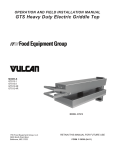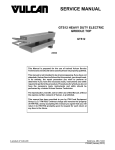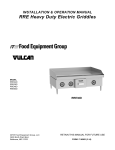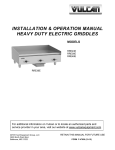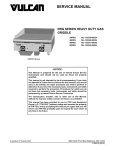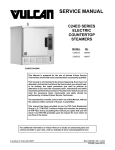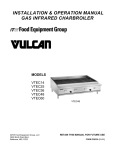Download Vulcan-Hart GTS12-1 Operation and Installation manual
Transcript
OPERATION AND FIELD INSTALLATION MANUAL GTS Heavy Duty Electric Griddle Top MODELS GTS12-1 GTS12-2 GTS12-3R GTS12-4R MODEL GTS12 ©ITW Food Equipment Group, LLC 3600 North Point Blvd. Baltimore, MD 21222 RETAIN THIS MANUAL FOR FUTURE USE FORM F-38300 (05-13) TABLE OF CONTENTS OPERATIONS Installation………………………………………………………………………………………….. 3 Electrical Specifications…………………………………………………………………………… 3 Controls…………………………………………………………………………………………….. 4 Raising/lowering griddle top………………………………………………………………………. 5 Using the griddle…………………………………………………………………………………… 6 Cleaning…………………………………………………………………………………………….. 6 Shutdown…………………………………………………………………………………………… 7 Maintenance……………………………………………………………………………………….. 8 FIELD INSTALLATION ASSEMBLY Tools required……………………………………………………………………………………… 8 Mounting bracket assembly………………………………………………………………………. 9 Mounting bracket installation……………………………………………………………………... 9 Griddle top installation…………………………………………………………………………….. 12 Flue deflector installation…………………………………………………………………………. 13 Tension rod spring assembly…………………………………………………………………….. 15 Range of motion…………………………………………………………………………………… 16 Electrical connections and specifications………………………………………………………. 17 Wiring diagrams……………………………………………………………………………………. 17 Troubleshooting…………………………………………………………………………………… 19 Accessories………………………………………………………………………………………… 20 -2- HEAVY DUTY ELECTRIC GRIDDLE TOP GENERAL Heavy Duty Electric Griddle Tops are produced with quality workmanship and materials. Proper installation, usage and maintenance of the griddle top will result in many years of satisfactory performance. Thoroughly read this entire manual before beginning and carefully follow all of the instructions provided. INSTALLATION Before installing, check the electrical service to make sure it agrees with the specifications on the rating plate. If the supply and equipment voltages do not agree, do not proceed with the installation. Contact your dealer or Vulcan-Hart immediately. INSTALLATION CODES AND STANDARDS Your Vulcan griddle top must be installed in accordance with: In the United States of America: 1. State and local codes 2. National Electrical Code ANSI/NFPA – 70 (latest edition) available from The National Fire Protection Association,1 Batterymarch Park,Quincy, MA 02269. 3. NFPA Standard #96 Vapor Removal from Cooking Equipment, (latest edition) available From the National Fire Protection Association, Batterymarch Park, Quincy, MA 02269. In Canada: 1. Local code 2. Canadian Electrical Code C22.1 Part 1 (latest edition) available from the Canadian Standard Association, 5060 Spectrum Way, Suite 100, Mississauga, Ontario, Canada, L4W 5N6. ELECTRICAL SPECIFICATIONS Model No Description Voltage GTS12‐1 GTS12‐2 GTS12‐3R Front Grease Trough Models 208 V 240 V 208 V 1 Phase Draw 3.6 kW 17.3 A 3.6 kW 15 A 3.6 kW 17.3 A 240 V 3.6 kW GTS12‐4R Rear Grease Trough Models -3- Power 15 A UNPACKING This griddle top was inspected before leaving the factory. The transportation company assumes full responsibility for safe delivery upon acceptance of shipment. Check for possible shipping damage immediately after unpacking. If the griddle is found to be damaged, save the packaging material and contact the carrier within 15 days of delivery. The griddle and its parts are hot. Use care when operating, cleaning or servicing the griddle. Disconnect power supply and follow lockout / tagout procedures before cleaning and servicing the appliance. BEFORE FIRST USE Remove all packaging material and protective plastic from the unit. It is recommended that you clean your Vulcan GTS griddle top thoroughly with a mild soap and water. Wipe the griddle surface thoroughly with water and wipe dry with a soft clean cloth. SEASONING THE GRIDDLE Each time, before turning the unit on, apply high temperature cooking oil – about two ounces per GTS top plate. Work the oil into the whole griddle surface. After cleaning your griddle with chemicals, you should repeat the seasoning procedure for proper cooking. CONTROLS The heavy duty electric griddle top section is independently controlled by a power switch, thermostat and high limit cutoff switch. When the power switch (red rocker switch) is turned ON, the left amber light will illuminate and power will be supplied to the thermostat. The thermostat cover must be removed to access the thermostat adjustment knob. When the thermostat is turned ON, the amber indicator light to the right of the power switch will illuminate to indicate that the element is on. When the griddle plate reaches the desired temperature set point, the element will be turned off and the amber indicator light will go off. The high limit cutoff switch is a safety feature that will cut power to the heating element to prevent overheating. The high limit switch can be reset by depressing the high limit reset button. At the end of each day, you must push the power switch to the OFF position to turn off power to the griddle top section. See Fig. A. -4- High Limit Reset Access Plug Thermostat Adjustment Knob Thermostat Cover Power Switch Trigger Handle High Limit Reset Button Fig. A Amber Indicator Lights Power Light (Left) Heating Light (Right) To raise the assembly to the 47˚ position 1. Lift by the handle only 2. Raise until assembly locks itself into place. See Fig. B Do not squeeze the trigger and handle together to raise the assembly. Do not force unit if it does not move up and down in the prescribed manner. The assembly may be damaged by the application of excessive up or down force. Contact an authorized service agent if assembly becomes difficult to move. Fig. B 2 To lower the assembly 1. Lift slightly from the handle (to take weight off) 2. Squeeze the trigger towards handle 3. Lower it to the desired position. Do not allow griddle top to fall to surface. See Fig. C 1 Fig. C -5- USING THE ELECTRIC GRIDDLE To preheat, wipe the griddle top plate with cooking oil and set the thermostats for the desired temperatures 10-12 minutes before cooking. A uniform and systematic approach to loading the griddle will produce the most consistent product results. REAR REAR REAR REAR FRONT FRONT FRONT FRONT The griddle plate is a composite material which is engineered to provide a high heat transfer rate to the food. The top surface is stainless steel and can be scored or dented by careless use of a spatula or scraper. Be careful not to dent, scratch, or gouge the plate surface. Do not try to knock off loose food that may be on the spatula by tapping the corner or the edge of the spatula on the griddle surface. Do not use hardened steel spatulas. Use mild steel spatulas with rounded corners. CARE AND CLEANING The griddle and its parts are hot. Use care when operating, cleaning or servicing the griddle. Clean the electric griddle top regularly. A clean griddle always looks better, lasts longer and performs better. To produce evenly cooked, perfectly browned griddle products keep the griddle plate clean and free of carbonized grease. Carbonized grease on the surface hinders the transfer of heat from the griddle surface to the food, resulting in spotty browning and loss of cooking efficiency. Carbonized grease tends to cling to griddle foods, giving them a highly unsatisfactory and unappetizing appearance. To keep the griddle clean and operating at peak efficiency, follow these procedures: AFTER EACH USE Clean the electric griddle top with a griddle scraper during the work shift. Keep the griddle scraper head flat to avoid scratching or gouging the plate. Use a cooking release agent to prevent product from sticking to the griddle top cooking surface. -6- ONCE PER DAY Thoroughly clean all stainless steel exterior panels and surfaces. Clean the cooking surface with a non-metallic scouring pad (Scotch-Brite™). ONCE PER WEEK Clean the griddle surface thoroughly. A mild detergent solution may be used on the plate surface to help clean it, but be sure the detergent is thoroughly removed by wiping down with clear water. After removal of detergent from the surface of the plate, the griddle should be coated with cooking oil according to the instructions in this manual. Clean stainless steel surfaces with a damp cloth and polish with a soft dry cloth. To remove discoloration, use a griddle cleaner. If the griddle usage is very high, consider conducting this weekly cleaning procedure more than once per week. Do not use a brick or griddle stone for cleaning. Do not use metallic scouring pads for cleaning. Do not use a water-jet to clean the griddle. Do not use chlorine sanitizer in contact with griddle. Contact can cause discoloration, corrosion and permanent damage. Do not use cleaning agents including Sodium Hydroxide, which is common in household oven cleaners. Contact can cause discoloration, corrosion and permanent damage. SHUTDOWN OF GRIDDLE 1. Set the power switch to the OFF position. This will shut down the griddle top completely. EXTENDED SHUTDOWN 1. Shut off the main electrical supply. -7- MAINTENANCE The griddle and its parts are hot. Use care when operating, cleaning or servicing the griddle. Disconnect power supply and follow lockout / tagout procedures before cleaning and servicing the appliance. LUBRICATION There are no parts on this unit that require lubrication. SERVICE AND PARTS INFORMATION Contact the Authorized Service Agency in your area to obtain service and parts information. For a complete listing of Service and Parts depots refer to www.vulcanequipment.com. When calling for service the following information should be available from the appliance serial plate: Model Number, Serial Number and voltage. FIELD INSTALLATION ASSEMBLY Contact the authorized service agency in your area for field installation. The field installation instructions are prepared for the use of trained service technicians and should only be used by those who are properly qualified. These instructions are not intended to be all encompassing. You should read, in its entirety, the installation instructions to determine if you have the necessary tools, instruments and skills required to perform the procedure. The field installation should not be attempted if you do not have the necessary tools, instruments and skills. TOOLS REQUIRED FOR FIELD INSTALLATION 1. #2 Philips head screw driver 2. M10 socket driver 3. 7/16” socket driver 4. Rubber mallet 5. Power drill 6. 7/8” deep well socket wrench 7. (2) large “F” clamps 8. 5/32” drill bits for metal 9. Thread lock compound (Loctite Blue®) 10. ¾” wide masking tape -8- ASSEMBLY The griddle and its parts are hot. Use care when operating, cleaning or servicing the griddle. Disconnect power supply and follow lockout / tagout procedures before cleaning and servicing the appliance. Prior to assembly, make sure the mounting bracket is the correct size. The back bracket should match the width of the griddle. Make sure the griddle top electrical specifications match the available service. Each griddle top will require its own separate electrical service. 1. Using (2) washers and (2) ¼”-28 bolts, assemble one of the side mount brackets to the back bracket as shown in Fig. 1. The bolts should be hand tightened only at this point. Repeat procedure to attach the other side mount bracket to the other end of the back bracket. Fig. 1 2. The entire mounting bracket system should be assembled at this point as shown in Fig. 2 with bolts hand tightened only. Griddle Top Assembly Mounting Points Fig. 2 3. Slide mounting bracket system onto back of the griddle as shown in Fig. 3. The left and right side brackets should be pushed up until stopped by the bottom of the griddle and pushed forward until stopped by the griddle back panel. Secure the mounting bracket system at this location with a “F” clamp on each side of the assembly as shown. Place a wood block or other type of protection between clamp and griddle plate. Fig. 3 -9- 4. Securely tighten the mounting bracket system assembly bolts at the left and right side mounting brackets. Fig. 4. 5. Check that the left and right mounting brackets have not moved from position while the assembly bolts were tightened. The “F” clamps should still be in place to prevent the assembly from moving while drilling holes in the chassis. Fig. 4 Check before drilling holes in chassis, it is important that the assembly has not moved from the location prescribed in step # 3 6. Using the side mounting bracket as a guide, drill holes into the griddle chassis with the 5/32” bits only at the highest hole and the hole nearest the front of the unit on the side bracket. See Fig. 5 and Fig 6. Repeat procedure for opposite side of bracket system assembly. Fig. 5 7. Insert and tighten 10-24 x ½ screws into the holes that were drilled in step 6. Repeat procedure for opposite side of bracket system assembly. See Fig. 6. Fig. 6 - 10 - 8. Drill the remaining holes through the side mounting brackets into the griddle chassis. Insert and tighten screws as shown in Fig. 7. Repeat procedure for the other side of the assembly. 9. Drill holes with 5/32” bits from the rear of the side mounting bracket into the back mounting bracket and install wall spacer with (4) 10-24 x ½” screws as shown in Fig. 8. Repeat procedure for the other side of the assembly. Fig. 7 Wall Spacer 10. Install one bottom support bracket every two feet of griddle width between griddle top mounting points as needed for additional support. Bottom support brackets should be flush with bottom of griddle chassis and back mounting bracket. Drill two holes with 5/32” bits and attach with 10-24 x 2” screws as shown in Fig.9 to the back mounting bracket. Repeat for each bottom support bracket needed. Fig. 8 Cutaway side view Fig. 9 Bottom support bracket - 11 - It may be necessary to angle the griddle and hang one of the four legs off the edge of the table at a time to complete step 11. Ensure that the griddle is safely supported and this step is accomplished with aid of a second person. 11. Drill two holes with 5/32” bits through bottom support brackets and into the bottom of griddle chassis. Insert and tighten 10-24 x 2” screws as shown in Fig.10. Repeat as necessary for all bottom support brackets. Fig. 10 Mounting Plate 12. Attach masking tape to mounting plate and slide into position between the griddle back panel and the top of the selected griddle top mounting point as shown in Fig. 11. Fig. 11 Griddle top mounting point Mounting Plate 13. Use tape to align holes in mounting plate with holes in griddle top mounting point as shown in Fig. 12. Tape to hold in position until installation of griddle top is complete. Repeat steps 12 and 13 for the bottom mounting point. Fig. 12 - 12 - 14. Place cardboard or other protective covering on the gas griddle surface to prevent scratching. 15. Set electric griddle top down on the gas griddle plate at desired mounting position. Lower rear arm assembly into place so that notches on arm engage mounting bracket rails as shown in Fig. 13. Fig. 13 16. Check that the flue deflector has been installed as shown in Fig. 14 before proceeding. Fig. 14 Flue Deflector - 13 - 17. Set lower mounting spacer in place. Apply a thread locking compound to (2) M10 hex bolts with lock washers. Insert the bolts through the mounting spacer and bracket. Thread into the mounting plate (set into place in step 13) and tighten. See Fig. 15. Repeat process for upper mounting point. M10 hex bolts and lock washers (upper mounting point) Mounting Spacer Fig. 15 M10 hex bolts and lock washers (lower mounting point) - 14 - The electric griddle top should be securely attached to the mounting brackets and raised in the locked 90° position before proceeding. Attempting to install tension springs in lowered position may cause damage. TENSION SPRING INSTALLATION Fig. 16 18. Raise the electric griddle top to the locked 90° position. Slide the springs onto the tension rods and then the spring bracket. The fin should be positioned at rear bottom and the radius edge bracket facing outwards. The electric cord will rest in this radius when assembled. See Fig. 16. (X) Spring Bracket GTS12‐1 & GTS12‐2 Threads showing (X) Head Weight (lb) Flush/ 0 +11 1 ‐2 7‐9 3‐4 4‐7 5 <2 19.Thread nuts onto end of tension rods. Tighten both nuts evenly to the desired head weight pressure suitable for your menu. Tightening the nuts further (compressing springs), will decrease the pressure applied to the cooking surface in the down position. See Fig. 17. GTS12‐3R & GTS12‐4R Threads showing (X) Head Weight (lb) Flush/ 0‐2 +11 3‐4 8‐9 5 5‐6 6 3‐4 Fig. 17 - 15 - 20. Reinstall the tension rod cover and tighten screws. Fig. 18 21. Check range of motion as shown in Fig. 19. The assembly should lock at the 90˚ and 47˚ positions. Assembly should release from locked positions when handles are squeezed together. Do not force unit down, it should lower under its own weight when the handles are squeezed. The cooking surface of the griddle top head assembly should just lightly touch the griddle surface of the bottom plate when the assembly is in the down position. Fig. 18 22. Repeat proceeding steps as needed for each griddle top head assembly. Fig. 19 - 16 - ELECTRICAL CONNECTIONS Electrical and grounding connections must comply with the applicable portions of the National Electrical Code and/or other local electrical codes. Disconnect the electrical power to the griddle and follow lockout / tagout procedures. Since the griddle top is not fused, you must connect to a fused circuit equipped with a suitable disconnecting means as required by local authorities. Electrical Connections 1. Remove the small junction box cover plate on the back of the unit. This exposes the GTS clamshell griddle line leads. 2. Select a suitable knockout on the sides or bottom of the junction box. 3. Connect the griddle’s line leads to the supply wires with factory supplied wire connectors as shown in the applicable wiring diagrams. 4. Push the excess wire into the junction box and replace the cover plate. Never operate griddle without cover in place. ELECTRICAL SPECIFICATIONS Model No Description Voltage Power 1 Phase Draw GTS12‐1 Front Grease Trough Models 208 V 3.6 kW 17.3 A 240 V 3.6 kW 15 A Rear Grease Trough Models 208 V 3.6 kW 17.3 A 240 V 3.6 kW 15 A GTS12‐2 GTS12‐3R GTS12‐4R - 17 - - 18 - TROUBLESHOOTING PROBLEM Heat does not come on when power switch is turned ON Heat does not come on when thermostat is turned ON Unit will not lock or remain in the raised position. Unit will not lower from the raised or locked position Unit will not raise from the cooking or lowered position Food under-cooked Food over-cooked Food is being crushed Food sticks to cooking surface POSSIBLE CAUSES 1. 2. 3. 4. Thermostat set too low. Turn to higher setting High limit cutoff switch is tripped – depress reset button. If power switch is not illuminated. Check breaker panel. If power switch is not illuminated, check if main power supply is disconnected (Call for service). 5. Problem with heating element, thermostat or power switch. (Call for service) 1. 2. 3. 4. 5. Power switch not in the ON position. High limit cutoff switch is tripped – depress reset button. Power not supplied to unit. Check breaker panel. Main power supply disconnected (Call for service). Problem with heating element, thermostat or power switch. (Call for service) 1. Lift by lower handle only. Do not squeeze upper and lower handles together when raising. 2. Not raising high enough. Unit will only lock at the 47˚ and 90˚ position. 3. Problem with locking mechanism or handles (Call for service) 1. Lift slightly (to take weight off) then squeeze the upper and lower handles together while lowering the unit. 2. Problem with locking mechanism (Call for service) 1. Problem with locking mechanism (Call for service) 1. Temperature set too low. 2. Food not cooked for long enough time. 3. Cooking surface not touching or partially touching food when in the lowered position. Tension springs need to be adjusted (Call for service) 1. Temperature set too high. 2. Food cooked for too long of a time. 3. Cooking surface pressing down too hard when in the lowered position. Tension springs need to be adjusted (Call for service) 1. Cooking surface pressing down too hard when in the lowered position. Tension springs need to be adjusted (Call for service) 1. Temperature set too high or too low. 2. Cooking surface needs to be cleaned. 3. Cooking surface not covered with enough cooking oil. - 19 - ACCESSORIES GTS12 ELECTRIC GRIDDLE TEFLON WRAP KIT INSTALLATION The griddle and its parts are hot. Use care when operating, cleaning or servicing the griddle. Teflon Sheet Sleeve Teflon Bracket 1. Clean off platen using soft cloth, water and mild soap solution. 2. Slide the Teflon bracket (#944503) into the sleeve of the Teflon sheet as shown in fig. 20. 4. Raise the platen to the 47° locked position. Drape the Teflon sheet (#944505) from the right side of the platen by hooking the front and back of the Teflon bracket to the Teflon retaining pins. See fig. 21. Fig. 20 Teflon Retaining Pin 5. Pull the Teflon sheet from the right side around the face of the platen cooking surface to the left side. 6. Pull the Teflon sheet tight and ensure the cooking surface of the platen is completely covered by the Teflon sheet. 7. Secure the Teflon sheet to the left side of the platen with the two Teflon clips (#944504). See fig. 22. GTS12 units that were shipped before March 2013 utilize a different Teflon sheet (#498852-1) and mounting system (two bars #498852-2 and three springs 498852-3). Fig. 21 Teflon Clip CARE AND CLEANING OF TEFLON WRAP 1. In between cooking runs and during idle Periods, the Teflon sheet should be wiped off with water and a clean soft cloth. 2. After each day the Teflon sheet should be removed from the platen(s), disassembled and placed in water with mild soap solution (no abrasive or harsh chemical cleaners should be used). Gently wash both sides of the Teflon sheet and the hardware with the soft clean cloth in the mild soap solution. Fig. 22 - 20 - 3. Using water, rinse the Teflon sheet and hardware thoroughly on both sides. 4. Dry the Teflon sheet and hardware using a clean soft cloth. 5. Before reassembling the Teflon sheet to the platen, clean the platen as described in Care and Cleaning section. GTS12 ELECTRIC GRIDDLE PLATE STABILIZER Slide plate stabilizer (fig. 23) onto the bottom handle as shown in fig. 24. Fig. 23 Fig. 24 GTS12 ELECTRIC GRIDDLE PLATE GAP ADJUSTER Slide plate gap adjuster (fig.25) onto the bottom handle as shown in figure 26. Fig. 25 Fig. 26 - 21 - NOTES - 22 -






















